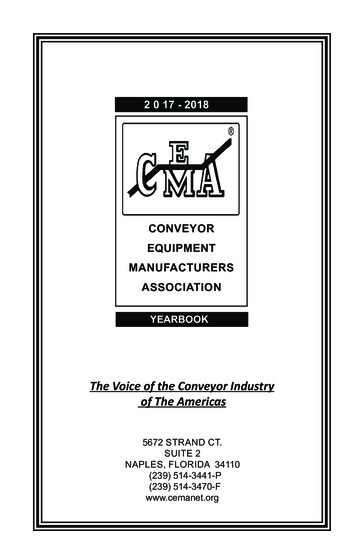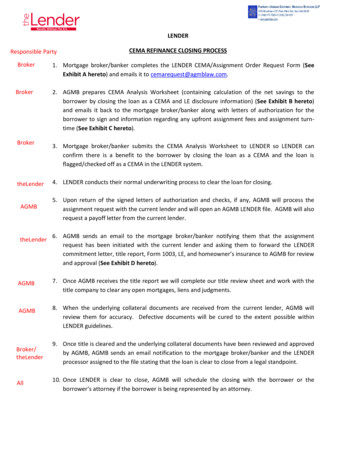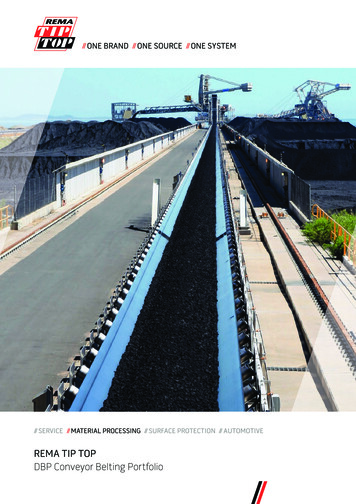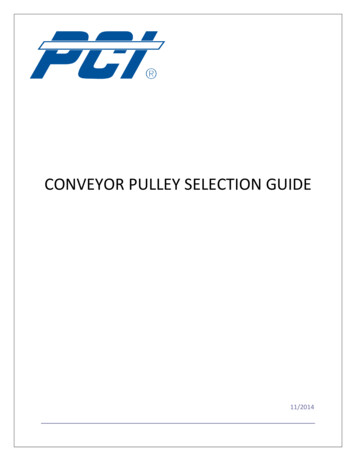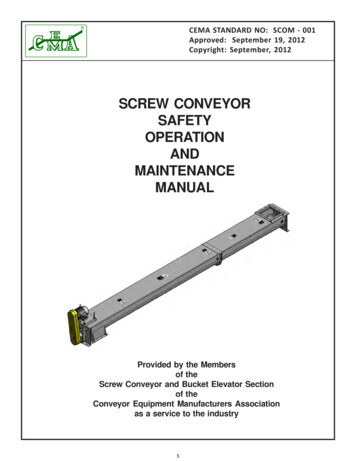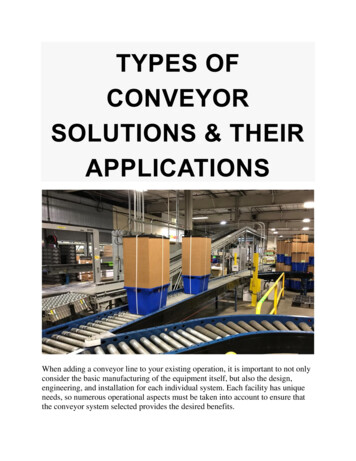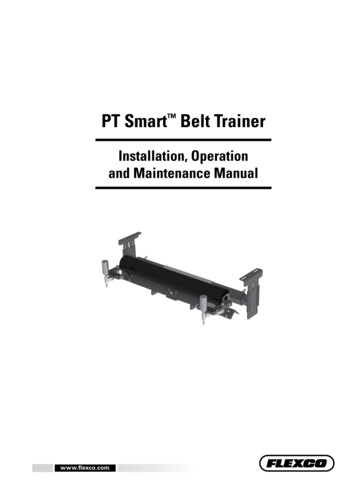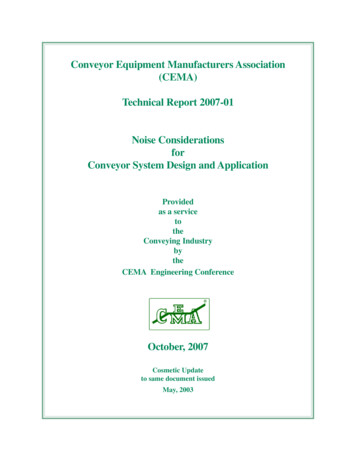
Transcription
CEMA Technical Report 2007-01Noise Considerations for Conveyor Equipment DesignConveyor Equipment Manufacturers Association(CEMA)Technical Report 2007-01Noise ConsiderationsforConveyor System Design and ApplicationProvidedas a servicetotheConveying IndustrybytheCEMA Engineering ConferenceOctober, 2007Cosmetic Updateto same document issuedMay, 2003October 2007
CEMA Technical Report 2007-01Noise Considerations for Conveyor Equipment DesignCEMA ORGANIZATIONAL CHARTCOMMITTEESOFFICERSBOARD OF DIRECTORSMeet in March and/or SeptemberConferenceUnit Handling Conveying SectionGeneral Bulk Handling SectionFinance and BudgetStrategic PlanningBulk HandlingComponentsand orChainPalletizersInsuranceMeets Each JuneMeetingsMembershipEngineering ConferencePast PresidentsIdlersCommitteesPulleysPublic RelationsConveyor ChainStatisticsSafety SteeringAccessoriesPerformance TerminologyUnit HandlingSectionBulk HandlingSectionBeltSystemsUnit Handling StandardsSafetyScrewConveyorsControlsTerms andDefinitionsInternationalStandardsBeltManualFor Information on Company Membershipvisit the CEMA Web Site athttp://www.cemanet.orgSAFETY NOTICEThe Conveyor Equipment Manufacturers Association has developed Industry Standard Safety Labelsfor use on the conveying equipment of its member companies.The purpose of the labels is to identify common and uncommon hazards, conditions, and unsafepractices which can injure, or cause the death of, the unwary or inattentive person who is workingat or around conveying equipment.The labels are available for sale to member companies and non-member companies.A full description of the labels, their purpose, and guidelines on where to place the labels on typicalequipment, has been published in CEMA’s Safety Label Brochure No. 201. The Brochure is availablefor purchase by members and non-members of the Association. Safety Labels and Safety LabelPlacement Guidelines, originally published in the Brochure, are also available free on the CEMAWeb Site at http://www.cemanet.org/CEMA Safety Pg.htmPLEASE NOTE: Should any of the safety labels supplied by the equipment manufacturer becomeunreadable for any reason, the equipment USER is then responsible for replacement and locationof these safety labels.Replacement labels and placement guidelines can be obtained by contacting your equipmentsupplier or CEMA.October 2007
CEMA Technical Report 2007-01Noise Considerations for Conveyor Equipment DesignTable of ContentsIntroduction .Fundamentals of Sound .Sound Measurement . .Noise Regulations . . .Noise Control Options . .Conveyor Design and Installation Issues . . . Rollers . . . . Roller Bearings . . Roller Shafts . . . Frames . . . . . Drives . . Pneumatic Devices . . . Conveyor Belts .Page 1Page 1Page 7Page 8Page 10Page ing Environment and Other End-User Considerations .Page 14Summary .Page 15References . .Page 16PurposeNoise Considerations for the Design, Specification, and Installation of Roller Conveyor Systemshavebeen developed by the member companies of the Conveyor Equipment ManufacturesAssociation(CEMA) to offer guidance to those considering noise in the design, specification, andinstallation ofconveyor systems.DisclaimerThese considerations are advisory only. They have been promulgated by the member companiesofCEMA with the sole intent of offering information for the design, specification, and installationofconveyor systems.CEMA makes no warranties (express, implied or statutory) in connection with these considerations.AcknowledgmentThe members of the CEMA Sound Committee thank the Conveyor Product Section of MaterialHandlingIndustry for allowing us to use their document "Noise Considerations for the Design,Specification, andInstallation of Roller Conveyor Systems" (published 1997) as a starter documentfor this project.October 2007i
CEMA Technical Report 2007-01Noise Considerations for Conveyor Equipment DesignIntroductionNoise can be defined as unwanted sound. Noise has an adverse impact on people andtheirperformance in the workplace. As such, it is good business practice to minimize exposure tonoise.However, in an industrial setting, there are generally many sources of noise. Each noisesourcecontributes to the total level of noise which a person may be exposed. However, reductionin noisefrom one or more of these sources may not significantly reduce the level of noise. Therefore,thetotal work environment (including the building structure and all sources of noise must beconsideredas an integrated system when addressing noise reduction. Focusing on only onecomponent of thatsystem (e.g., the material handling system) may not yield the level of noisereduction desired.These guidelines have been developed by the Engineering section of The ConveyorEquipmentManufacturers Association (CEMA) to address noise reduction issues related to thedesign andinstallation of conveyor systems. As such, it addresses the impact of only one noisesource (thematerial handling system) and its impact on the total work environment. However,many of theguidelines discussed are also more generally applicable to other noise sources (e.g.,productionequipment). These should help you develop specifications for the design and installationofconveyor systems that will help meet hearing safety standards for the total work environment.Fundamentals of SoundThe vibrating motion of displaced molecules in an elastic medium creates sound. This mediumcanbe air, wood, steel, or other materials. This vibration produces waves, which radiate in alldirections,much like ripples on a pond. As these waves travel through air, a small pressure change,above andbelow atmospheric pressure, is created. Our ear is able to sense this change, enabling usto hear.This change in pressure is known as sound pressure level. The sound pressure level is themeasure ofsound most commonly referred to when discussing industrial noise control. It is easilymeasuredusing simple hand-held devices. People are able to hear sound pressure levels betweenabout 3x10-9 psi and 3x10-2 psi. Higher sound pressure levels are painful and dangerous even forvery shortdurations. Therefore, the useful hearing range is about seven orders of magnitude interms of soundpressure levels. Since sound intensity and sound power are proportional to soundpressure squared,the useful hearing range spans 14 orders of magnitude in terms of intensity orpower. To describethis huge range of levels with manageable numbers, the logarithmic decibelscale is used. Each orderof magnitude represents one Bel or 10 decibels (dB). Therefore, theuseful hearing range starts atabout 0 dB and extends to about 140 dB.Frequency is defined to be the rate at which molecules vibrate. A given noise source containsmanydifferent component frequencies. The sound pressure level may vary for different frequenciesasshown in Figure 1 on the next page.October 20071 of 16
CEMA Technical Report 2007-01Noise Considerations for Conveyor Equipment DesignFigure 1: Sound Pressure Level Versus FrequencyThe human ear is able to perceive a relatively narrow frequency range, from 30 to 17,000 Hz.Whenmeasuring sound pressure level, it is convenient to express sound pressure level as a singlenumberrather than as a function of frequency. The A-scale on common sound level meters uses aweightingscheme, which closely follows the frequency response of the human ear. This enablessoundpressure level to be expressed as a single measure denoted as dBA. The A-scale plays aprominentrole in noise control.Our subjective sense of loudness is not directly proportional to the actual sound energy orpowerinvolved. For example, a 3 dB increase represents a doubling of actual energy, but it isjustnoticeable. A 5 dB increase represents a tripling of actual energy, but is perceived as beingonlyclearly louder. A 10 dB increase represents 10 times as much energy, but it sounds only twiceasloud. Table 1 is useful in understanding this point.Change in Energy LevelChange in Sound LevelChange in Subjective Loudness26%1 dBInsignificantDoubling3 dBJust PerceptibleTripling5 dBClearly noticeable10 Times10 dBTwice as loud (or half as loud)100 Times20 dBMuch louder (or quieter)Table 1: Change in sound loudnessSound power measures the flow rate of acoustical energy from a sound source and is independentof any point in space or time. A sound source radiates power, which results in sound pressure.Sound power is the cause and sound pressure is the effect or what we hear. Sound power and soundpressure are frequently confused. This is partly because they are both measured in decibels. Thelogarithmic decibel scale is also used to measure sound power because the range of values overwhichsound power (measured in watts) typically varies is extremely wide. However, sound power isanalogous to the power rating of a light bulb. Experience indicates that a 100 watt light bulb isbrighter (light intensity or illumination) than a 25 watt bulb at any given distance. Similarly, thesound pressure level created by a sound source of 100 watts (140 dB) is greater than that created bya 25 watts source at any given distance. Sound pressure level is a function of distance. Soundpoweris independent of distance. Table 2 shows some common sound sources and the approximatesoundpower generated by those sources.October 20072 of 16
CEMA Technical Report 2007-01Noise Considerations for Conveyor Equipment DesignCommon Sound SourceNoise/Sound Power Level (dB)Boom CarsJet Engines (near)Shotgun FiringJet Takeoff (100-200 ft.)Rock Concerts (varies)Oxygen TorchDiscotheque/Boom BoxThunderclap (near)Stereos (over 100 watts)Symphony OrchestraPower Saw (chainsaw)Pneumatic Drill/JackhammerSnowmobileJet Flyover (1000 ft.)Electric Furnace AreaGarbage Truck/Cement MixerFarm TractorNewspaper PressSubway, Motorcycle (25 ft.)Lawnmower, Food BlenderRecreational Vehicles, TV145140Diesel Truck (40 mph, 50 ft.)Average City Traffic130110–140121Threshold of pain begins around 125 dB120Threshold of sensation begins around 120 dB110–125110Regular exposure to sound over 100 dB of more thanone minute risks permanent hearing loss.105103No more than 15 minutes of unprotected exposurerecommended for sounds between 90–100 dB.10098978885–9070–90Very annoying85 dB is the level at which hearing damage (8 hrs.)begins8480Garbage DisposalWashing MachineDishwasherVacuum Cleaner, Hair DryerNormal ConversationQuiet OfficeRefrigerator HummingWhisperBroadcasting StudioRustling LeavesNormal BreathingEffectAnnoying; interferes with conversation; constantexposure may cause damage78757050–6550–604030302010Intrusive; interferes with telephone conversationComfortable hearing levels are under 60 dB.Very quietJust audibleThe threshold of normal hearing starts at about 1000 to4000kHz.Table 2: Sound power level of common soundsThe relationship between sound power and sound pressure level for a point source in a free fieldisgiven by the following equation:Lp Lw - 20 log10 (r) -11where Lp sound pressure level (dB)Lw sound power (dB)r distance from sound source (meters)For a point source on a hard surface outdoors with no other reflecting surfaces nearby, soundwavesradiate in a hemisphere above the surface rather than a sphere. The total sound power is thesame, but the hemisphere has only half the surface area of a sphere. Therefore, the sound intensityis doubled at any given distance, and the sound level is 3 dB higher. This factor is referred to asdirectivity, and a flat surface has a directivity (Q) of 2 in the following equationLp Lw 10 log Q - 20 log10 (r) - 11This equation is frequently used in acoustics. As an illustration, consider a lawn mower in themiddle of alarge concrete parking lot with no other reflective surfaces nearby. For purposes of theOctober 20073 of 16
CEMA Technical Report 2007-01Noise Considerations for Conveyor Equipment Designillustration, we will assume that the lawn mower radiates noise uniformly in all directions. If thelawn mower produces asound power level of 110 dBA, what is the sound pressure level at 5 meters?Lp 110 10 log 2 - 20 log10 (5) - 11Lp 88 dBAAs reported earlier, sound pressure level can be easily measured using a sound level meter. However,sound power is not easily measured. Therefore, another useful equation expresses sound pressurelevel as a function of the distance from the noise source. Let Lp,1 and Lp,2 be the sound pressurelevels at a distance r1 and r2 respectively, from the noise source. The resulting relationship betweenthese sound pressure levels is:Lp,2 Lp,1 - 20 log10 (r2/r1)Therefore, if the sound pressure level is 90 dB at 5 meters from the source, what is the soundpressure level at 10 meters from the source?Lp,2 90 - 20 log10 (10/5)Lp,2 84 dBThis illustrates an often quoted rule of thumb that states that the sound pressure level decreases by6dB when the distance from the noise source is doubled.The preceding equations are useful for sound sources located outdoors without building, fences, orother similar reflective surfaces in the vicinity. However, when a source is located indoors, thewalls and roof contain the sound energy. These surfaces reflect sound back into the space, and cancause the overall level to increase quite significantly. This is called reverberant build-up of soundenergy. In a real production facility with many sources distributed throughout the space, the soundlevel may drop off by several dB as you move a short distance away from a source. However, thesound levels may then remain fairly constant as you move farther away because reverberant noiseenergy becomes more significant than noise radiated directly from a source. Therefore, it is importantto include absorptive wall and ceiling treatments in any facility where significant noise is generatedto control reverberant noise.When there are multiple sound sources, Lp,i, the resultant sound pressure level, Lp,t, at a givendistance can not be determined algebraically. Since the sound pressure level is measured using alogarithmic scale, the following equation is used to determine the combined effect.Lp,t, 10 log(n3 10Lp,t,i 1)10dBExample: What is the total sound pressure level due to the following individual sources?Conveyor A at 76.0 dBAConveyor B at 75.0 dBAConveyor C at 68.0 dBAConveyor D at 72.0 dBAOctober 200710 7.610 7.510 6.810 7.24 of 16 39.8EE631.6EE66.3EE615.8EE6
CEMA Technical Report 2007-01Noise Considerations for Conveyor Equipment DesignConveyor E at 75.5 dBA10 7.55 35.5EE6Ambient Noise at 75.0 dBA10 75 31.6EE6Total 160.7EE6L(total) 10 log 160.7EE6 82.1 dBAThis equation yields two useful rules of thumb. When two equal sound sources are combined, theresulting sound pressure level will be only 3dB higher. If two different sound sources are combinedand the difference between the two levels being added is 10 dB, the combined sound pressure levelwill only be 0.5 dB higher than the higher of the two sources. The additive effect of noise isillustrated in Table 3 and the graph in Figure 2.Table 3: Addition of sound sourcesFigure 2: Addition of sound sourcesOctober 20075 of 16
CEMA Technical Report 2007-01Noise Considerations for Conveyor Equipment DesignExample:All noise sources are approximately equidistant from the observer. Individual equipment readingsare obtained from manufacturer or direct observation in a “quiet room” (Ambient level less than50dBA).Conveyor A ------------76.0 dBAConveyor B ------------75.0 dBAConveyor C ------------68.0 dBAConveyor D ------------72.0 dBAConveyor E ------------75.5 dBAAmbient Noise F ------75.0 dBAOctober 20076 of 16
CEMA Technical Report 2007-01Noise Considerations for Conveyor Equipment DesignSound MeasurementThe primary instrument used to measure sound pressure level in the field is the sound level meter(seeFigure 3). The A scale and “slow” response should be used to integrate different soundfrequenciesinto a single composite measure (dBA). For reliable and accurate sound level measurements,background noise should be reduced to a minimum. Measurements taken when the difference inlevel between total noise and background noise is 3 dB or less should be avoided. In addition,sound can bounce or reflect from some surfaces. Severe measurement errors can and often dooccur in industrial environments where reflective surfaces are present. This is especially truewhen these reflective surfaces are in close proximity to a noise source (e.g., a hard masonry wallclose to a conveyor).Figure 3: Typical sound level meterThe sound pressure level surrounding a source of noise will be a function of many factors. Therefore,the most realistic portrait of the noise a humanoperator will be exposed to can be obtained froma noise contour map. A noise contour mapprovides a visual image of the sound field overan area as shown in Figure 4.A noise contour map can be easily developedusing the following 3-step process.1. Using the A-scale and “slow” responsesettings on a sound level meter, walk aroundthe sound source, maintaining a constantreading (e.g., 80dBA). Record your path untilit closes on itself, forming a loop, or until thepath exits the area to be surveyed.2. Trace the path followed on a plant layout orarea map. This can most easily be done by asecond person following the surveyor.3. Repeat the process for as many contours asdesired or needed.Figure 4: Noise contour mapOctober 20077 of 16
CEMA Technical Report 2007-01Noise Considerations for Conveyor Equipment DesignNoise RegulationsThe Occupational Safety and Health Administration (OSHA) limitS the noise to which employeesare exposed during the normal course of their employment. In order to fully understand OSHA’sregulations, the complete text of 29 CFR 1910.95 should be carefully studied. Following is a briefsummary of the key requirements of the July 1, 1998 revision of this regulation. Always check themost current revision of this federal regulation as well as any state or local regulations that mayapply to your particular application.OSHA regulations become applicable when an operator’s exposure exceeds a time-weighted averagelevel of 85 dBA for an eight-hour period. Noise levels which exceed 85 dBA are of no significanceto OSHA unless they occur in a location where operators are exposed to them. OSHA is concernedonly with operator exposure to high noise levels - not with noise levels per se.Where workers are exposed to a daily noise level of 85 dBA or more, employers are required toinitiate a hearing conservation program. Hearing protectors must be made available, and signsmust be posted warning of potential hearing damage. CEMA has a caution label designed to beplaced onequipment to notify workers of hazardous noise levels (see Figure 5). More informationconcerning the purchase of these and other safety labels may be obtained at http://cemanet.org/safety/index.html. Employees must be given audiograms on a regular basis to detect possibleprogressive hearing loss. Fairly elaborate record keeping is also required.Figure 5: CEMA hearing protection labelWhen an operator’s exposure exceeds a time-weighted average level of 90 dBA for an eight-hourperiod, the use of hearing protectors becomes mandatory. Feasible engineering or administrativecontrols must also be implemented.Engineering controls usually consist of process modifications, silencers, machine or operatorenclosures, or the addition of acoustical absorption to the area. An acceptable alternate isadministrative control in which the daily cumulative exposure to noise is limited by moving workersout of noisy areas in a systematic rotation. For any period spent in areas where the noise levels arebelow 80 dBA, operator exposure is considered to be zero.October 20078 of 16
CEMA Technical Report 2007-01Noise Considerations for Conveyor Equipment DesignOnce noise contours have been defined, the risk to human operators can be established. Thepermissible levels of noise exposure specified by the U.S. Department of Labor in the OccupationalSafety and Health Act are time-weighted average exposures. OSHA regulations become applicablewhen an operator’s exposure exceeds a time-weighted average level of 85 dBA for an 8-hour period.The permissible levels of exposure to occupational noise permitted by OSHA are shown in Table 4.The portion of time an operator is projected to spend working in a given sound field can be estimatedand the level of exposure calculated. For these calculations to be valid, the sound field must bedefined based upon reasonable operating expectations. The amount of noise in the work environmentdepends upon more than the level of noise generated by the conveyor itself. It also depends uponthe speed at which the conveyor is operated, the nature and type of the unit load carrier used, thepresence of other noise sources near the operating area, the architectural design of the buildinghousing the system, and other considerations.Sound level dBA slow responseDuration per day, hours90929597100102105110115864321 1/211/21/4 or lessFootnote(1) When the daily noise exposure is composed of two or more periodsof noise exposure of different levels, their combined effect should be considered,rather than the individual effect of each. If the sum of the following fractions:C(1)/T(1) C(2)/T(2)C(n)/T(n) exceeds unity, then, the mixed exposure should beconsidered to exceed the limit value. Cn indicates the total time of exposure at aspecified noise level, and Tn indicates the total timeTable 4: Permissible Levels of Exposure to Occupational Noise.Ref. OSHA 1910.95(b)(2), Table G-16Ideally, the design specification should specify the operating environment in which the conveyorsystem must function. No one can accurately predict what the overall sound levels in a facility willbe until after the system is up and operating in the intended configuration. However, there areseveral options for reducing the noise associated with these systems. These are discussed in thenext section.October 20079 of 16
CEMA Technical Report 2007-01Noise Considerations for Conveyor Equipment DesignNoise Control OptionsThere are several options to be considered when seeking to reduce workplace noise. These include:1. Do not make the noise.2. Modify or substitute processes and components that generate less noise.3. Use vibration isolation or damping.4. Absorb acoustic energy.5. Shield or enclose the noise source or the receiver.6. Combine or integrate solutions.Noise can be controlled at the source, anywhere along its transmission path, or at the receiver. Theprimary goal should always be to reduce noise at its source. Often the most effective noise reductionapproaches involve simple design changes to reduce the noise generated. A second approach involvesmodifying or substituting processes and components to reduce noise. For example, belts can besubstituted for gears or free-fall conveying processes can be avoided. Cushioning impact points orsubstituting plastics for metal parts can be effective ways to isolate vibration or dampen sound.The use of acoustical materials to absorb sound within housings, enclosures, and buildings is anotheroption frequently used. Alternatively, the noise source can be partially or fully enclosed. Properlydone this can be very effective. However, if done incorrectly, it can be a complete failure or it mayeven amplify the noise from a source. Frequently, effective noise control requires a combination ofthese solution approaches.There are many different types of conveyors frequently used in commerce and industry. The diversityof conveyor operating environments, conveyor designs, and installation options makes it impossibleto specify a general solution to noise control problems. Noise control must be apartnership betweenthe conveyor supplier and the end user. There are many different facets to the noise control problem.The conveyor supplier can address some of these issues like conveyor designand installation.However, other issues like the operation environment and maintenance of unit load carriers arecontrolled by the end user. Working together in a partnership, noise control options canbe identifiedand analyzed based upon user requirements. The following sections address the major concernsthat must be addressed by this partnership.Conveyor Design and Installation IssuesThere are potentially many different approaches to noise control, which can be developed. Differentconveyor suppliers offer a range of conveyor designs. Different designs offer different challengeswhen it comes to noise control. What may be a noise control issue for one supplier may not be anissue for another supplier. Each conveyor design provides unique challenges and opportunities.For example, roller tube ringing is a common source of noise in conveyor systems. One costeffective approach to this problem utilizes lined or covered tubes. However, some line shaft conveyorsuppliers have found that the drive belt on these designs has a damping effect on this ringing soundand have found it unnecessary to use lined tubes. In addition, the type of unit load being conveyedmay dampen this ringing. Therefore, to specify that lined or covered tubes be used may not providea cost-effective solution in all applications.October 200710 of 16
CEMA Technical Report 2007-01Noise Considerations for Conveyor Equipment DesignRecognizing that different conveyor designs offer different noise control opportunities, whatproblems commonly occur? A typical powered roller conveyor system consists of threemajorcomponents as shown in Figure 6. These are the structural framework, the drive mechanism,and the conveyor rollers. In a complex conveyor system, there are typically a limited number ofstructural frameworks and drive mechanisms. However, there are hundreds or thousands of conveyorrollers in use. These rotating rollers can frequently be the major source of noise in many conveyorsystems.Figure 6: Example of a powered roller conveyorRollersConveyor rollers can be a major source of the noise produced by high-speed conveyor systems.Most conveyor rollers are hollow metal tubes that resonate as conveyed materials move over them.In many high-speed roller conveyor systems, there is a constant “ringing” sound emanating fromthe roller tubes. This ringing can be reduced by using a plastic tube material or by covering orlining the tube with a sound absorbing material or vibration damping material.With roller conveyors, the noise level is also a function of speed; as speed increases, the noise levelincreases. A 50% increase in speed can cause a 3 to 5 dB increase in noise level. At double theoriginal speed, the level is 6 to 7 dB higher. At very high speeds the noise increases stop or leveloff, i.e., the noise versus speed curve flattens out, and slight reductions in noise levels have beenobserved at even higher speeds. This implies that the noise versus speed curve is convex and hasa peak.Roller BearingsFactors which influence noise generated from bearings include; the smoothness of the raceway(ground or unground), the level of precision of the ball (roundness and variation in diameter), ballseparators (cages) and types of lubricant. In general, noise levels decrease as the quality of thebearing increases.October 200711 of 16
CEMA Technical Report 2007-01Noise Considerations for Conveyor Equipment DesignThere are typically three types of bearings used in conveyor rollers. Stamped commercial gradecageless bearings utilize hardened unground steel balls and raceways with a full compliment ofballs. These are the most economical bearings used in conveyor rollers. The next step up in qualityis the stamped commercial grade “semi-precision” bearing. These bearings have hardened ungroundsteel balls and raceways but utilize a stamped sheet metal cage to separate the balls. The highestquality bearings used in conveyor rollers are ABEC-1 precision bearings. They utilize hardenedand ground balls and raceways with a caged ball complement. In most clean area applications,ABEC-1 precision bearings also offer longer life and lower maintenance and operating costscompared to traditional bearings.Noise reductions can be significant when ABEC-1 precision bearings are used versus stampedcommercial grade cageless bearings. At lower speeds the individual balls in a cageless bearing will“fall” in the raceway causing a readily identifiable “pinging or tinkling” sound. At higher speedsthe balls are held against the raceway by centrifugal force and this sound is not present. ABEC-1bearings have a caged ball compliment which eliminates any noise from the balls regardless ofspeed.Table 5 shows the difference in noise levels at varying speeds between commercial grade cagelessbearings and ABEC-1 precision bearings. This data is to be used as a guideline only – results willvary greatly depending on bearings, method of securing roller shafts in frames, frame material anddesign, and method used to drive the rollers.Range of sound leveldifference (dB)Speed (FPM)1207 - 171808.5 - 192409.3 - 20Table 5: Sound level of commercial vs. precision bearingsNote: Above range of values were determined from sound measurements on various types ofconveyors at a distance of 3 feet from the rollers. Sound levels are A scale, slow response.Roller ShaftsShaft clatter can be another significant contributor to noise from conveyor rollers. While themanufactured roller is reasonably round, there will be some ovality and some imbalance. Theseissues are accentuated at high speeds. As speed increases, rollers begin to bounce in the framecreat
CEMA Technical Report 2007-01 Noise Considerations for Conveyor Equipment Design October 2007 Conveyor Equipment Manufacturers Association (CEMA) Technical Report 2007-01 Noise Considerations for Conveyor System Design and Application Provided as a service to the Conveying Industry by the CEMA Engineering Conference October, 2007 Cosmetic Update
